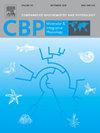生物钟控制着虹鳟鱼肠道的日常功能。光和食物作为同步器的影响。
IF 2.2
3区 生物学
Q4 BIOCHEMISTRY & MOLECULAR BIOLOGY
Comparative Biochemistry and Physiology A-Molecular & Integrative Physiology
Pub Date : 2025-02-05
DOI:10.1016/j.cbpa.2025.111821
引用次数: 0
摘要
环境因素(每日光/暗周期,食物供应等)在生物体中携带内源性振荡器,从而使它们能够控制行为和生理功能的节奏,例如能量稳态。胃肠道(GIT)是食物摄入后营养物质接触的第一个部位。因此,GIT是能量稳态的关键。昼夜节律振荡器存在于哺乳动物的胃肠道中,调节组织的日常功能。然而,其他脊椎动物,如鱼类,在这方面的信息很少。因此,我们的目的是确认虹鳟鱼(Oncorhynchus mykiss) GIT中昼夜节律振荡器的存在,以及它与参与该物种摄食调节的局部释放激素的相互作用。我们随后评估了食物和光在同步GIT节律功能中的作用。根据我们的研究结果,基于时钟基因(clock1a, bmal1b, per1, cry2和reb-ervβ样)mRNA丰度的日常节律,在虹鳟鱼的GIT中存在昼夜节律振荡器。光影响GIT内昼夜节律振荡器的功能,但食物是同步器的关键因素。进食时间和食物的存在和/或不存在会同步GIT的节律功能,正如对GIT激素(Ghrelin, Glp1和Cck)所观察到的那样。了解GIT等外周器官中昼夜节律机制的功能最终将有助于改善水产养殖的各个方面,从养殖策略到福利等。本文章由计算机程序翻译,如有差异,请以英文原文为准。

A circadian clock controls the daily function of the intestine in rainbow trout. Influence of light and food as synchronizers
Environmental factors (daily light/dark cycles, food availability, etc.) entrain endogenous oscillators in living organisms, thereby allowing them to control the rhythms of behavioral and physiological functions, such as energy homeostasis. The gastrointestinal tract (GIT) is the first site of nutrient contact upon food intake. Thus, the GIT is key in energy homeostasis. Circadian oscillators exist within the GIT of mammals, modulating the daily function of the tissue. However, little information in this respect is available for other vertebrates, such as fish. Thus, we aimed to confirm the presence of a circadian oscillator within the GIT of rainbow trout (Oncorhynchus mykiss) and its interaction with locally released hormones that participate in feeding regulation in this species. We subsequently evaluated the role of food and light in synchronizing the rhythmic functioning of the GIT. According to our results, a circadian oscillator exists throughout the GIT of rainbow trout, based on the daily rhythms of clock gene (clock1a, bmal1b, per1, cry2 and reb-ervβ-like) mRNA abundance. Light influences the function of the circadian oscillator within the GIT, but food is a key factor as a synchronizer. The feeding time and the presence and/or absence of food synchronize the rhythmic function of the GIT, as observed for GIT hormones (Ghrelin, Glp1 and Cck). Understanding the functioning of the circadian machinery in peripheral organs such as the GIT will ultimately help to improve different aspects of aquaculture, from farming strategies to welfare, among others.
求助全文
通过发布文献求助,成功后即可免费获取论文全文。
去求助
来源期刊
CiteScore
5.00
自引率
4.30%
发文量
155
审稿时长
3 months
期刊介绍:
Part A: Molecular & Integrative Physiology of Comparative Biochemistry and Physiology. This journal covers molecular, cellular, integrative, and ecological physiology. Topics include bioenergetics, circulation, development, excretion, ion regulation, endocrinology, neurobiology, nutrition, respiration, and thermal biology. Study on regulatory mechanisms at any level of organization such as signal transduction and cellular interaction and control of behavior are also published.

 求助内容:
求助内容: 应助结果提醒方式:
应助结果提醒方式:


